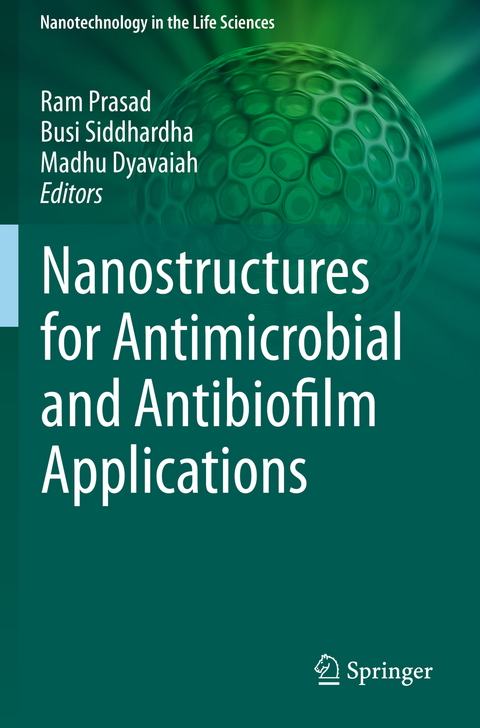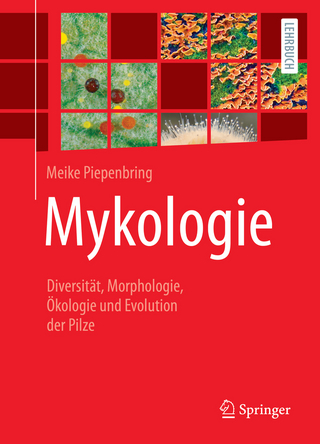
Nanostructures for Antimicrobial and Antibiofilm Applications
Springer International Publishing (Verlag)
978-3-030-40339-3 (ISBN)
In the pursuit of technological advancement in the field of biotechnology and pharmaceutical industries to counteract health issues, bacterial infections remain a major cause of morbidity and mortality. The ability of bacterial pathogens to form biofilms further agglomerates the situation by showing resistance to conventional antibiotics. To overcome this serious issue, bioactive metabolites and other natural products were exploited to combat bacterial infections and biofilm-related health consequences. Natural products exhibited promising results in vitro, however; their efficacy in in vivo conditions remain obscured due to their low-solubility, bioavailability, and biocompatibility issues. In this scenario, nanotechnological interventions provide a multifaceted platform for targeted delivery of bioactive compounds by slow and sustained release of drug-like compounds. The unique physico-chemical properties, biocompatibility and eco-friendly nature of bioinspired nanostructures has revolutionized the field of biology to eradicate microbial infections and biofilm-related complications.
The green-nanotechnology based metal and metal oxide nanoparticles and polymeric nanoparticles have been regularly employed for antimicrobial and antibiofilm applications without causing damage to host tissues. The implications of these nanoparticles toward achieving sustainability in agriculture by providing systemic resistance against a variety of phytopathogens therefore plays crucial role in growth and crop productivity. Also the advent of smart and hybrid nanomaterials such as metal-based polymer nanocomposites, lipid-based nanomaterials and liposomes have the inherent potential to eradicate bacterial biofilm-related infections in an efficient manner.
The recent development of carbon-based nanomaterials such as carbon nanotubes (CNTs) and silica based nanomaterials such as mesoporous silica nanoparticles (MSNs) also exploit a target of dreadful healthcare conditions such as cancer, immunomodulatory diseases, and microbial infections, as well as biofilm-related issues owing to their stability profile, biocompatibility, and unique physio-chemical properties.
Recently novel physical approaches such as photothermal therapy (PTT) and antimicrobial photodynamic therapy (aPDT) also revolutionized conventional strategies and are engaged in eradicating microbial biofilm-related infections and related health consequences. These promising advancements in the development of novel strategies to treat microbial infections and biofilm-related multidrug resistance (MDR) phenomenon may provide new avenues and aid to conventional antimicrobial therapeutics.
Ram Prasad, Ph.D. is associated with Amity Institute of Microbial Technology, Amity University, Uttar Pradesh, India since 2005. His research interest includes applied microbiology, plant-microbe-interactions, sustainable agriculture and nanobiotechnology. Dr. Prasad has more than hundred publications to his credit, including research papers, review articles & book chapters and five patents issued or pending, and edited or authored several books. Dr. Prasad has twelve years of teaching experience and has been awarded the Young Scientist Award (2007) & Prof. J.S. Datta Munshi Gold Medal (2009) by the International Society for Ecological Communications; FSAB fellowship (2010) by the Society for Applied Biotechnology; the American Cancer Society UICC International Fellowship for Beginning Investigators, USA (2014); Outstanding Scientist Award (2015) in the field of Microbiology by Venus International Foundation; BRICPL Science Investigator Award (ICAABT-2017) and Research Excellence Award (2018). He has been serving as editorial board members: Frontiers in Microbiology, Frontiers in Nutrition, Academia Journal of Biotechnology including Series editor of Nanotechnology in the Life Sciences, Springer Nature, USA. Previously, Dr. Prasad served as Visiting Assistant Professor, Whiting School of Engineering, Department of Mechanical Engineering at Johns Hopkins University, USA and Research Associate Professor at School of Environmental Science and Engineering, Sun Yat-sen University, Guangzhou, China. Busi Siddhardha, Ph.D. is a full-time Assistant Professor at the Department of Microbiology, Pondicherry University (a central university) Puducherry, India from 2011. Prior to joining the Pondicherry University, he was teaching at the Gurukul Kangri University, Haridwar. In brief, he has got more than 12 years of research and 7 years of teaching experience at the university level. Currently, there are five Ph.D. students under his guidance. He has published more than 60 research articles/book chapters in the leading national and international journals. Dr. Siddhardha has successfully completed two research projects on "quorum sensing attenuation and antibiofilm activity of natural products" funded by DST-SERB and UGC, India. Currently, he is a principle investigator of a project on "attenuation of quorum sensing and biofilm mediated virulence of Pseudomonas aeruginosa by selected phytochemicals and understanding the mechanism of action" funded by DST-SERB (2018-2021). His current areas of research interests include antimicrobial drug discovery, nanobiotechnology, antivirulence therapy targeting bacterial quorum sensing and biofilms, and antimicrobial photodynamic therapy. He pursued his Ph.D. in Biology Division from CSIR-IICT, Hyderabad, India. He has been awarded Junior Research Fellowship by Council for Scientific and Industrial Research (CSIR), India in the year 2005. He is editorial board member of several reputed journals. He is a member of many national and international scientific societies. Madhu Dyavaiah, Ph.D., is an Assistant Professor, in the Department of Biochemistry and Molecular Biology; Pondicherry University, Pondicherry. He has served as a Research Scientist in the Gen'NY'sis Center for Excellence in Cancer Genomic, University at Albany, USA (2006-2012), Postdoctoral fellow at Wadsworth Center, New York Dept. of Health, USA (2003-2006) and IISc. Bangalore, India (2002-2003). His research interest includes, Molecular Pathogenesis, DNA damage response, tRNA modification and translation regulation and aging biology. He has research experience in working with microbial pathogens includes, Cryptococcus, Candida and Fusarium spaces. Currently, he is working with different model systems such as S. cerevisiae and mice model to study the effect of natural compounds on age-related diseases including neurodegenerative diseases and cancer. He has been conferred with various prestigious awards in USA and India. He has served as referee for a number of International journals, including Food Sciences and Toxicology Research. He has more than 15 years of research and 8 years of teaching experience in Genomics, Proteomics, Molecular Biology, Clinical Biochemistry Biology and Drug Discovery. He has also published more than 20 research articles and a review in the peer-reviewed international journal, and authored three book chapters, which includes a chapter, "Yeasts: Candida and Cryptococcus" in the book entitled "Bacterial and Mycotic Infections in Immunocompromised Hosts: Clinical and Microbiological Aspects" He is a member of many scientific societies and organizations.
Preface.- Polymer Macromolecules to Polymeric Nanostructures: Efficient antibacterial candidates.- Algal Nanoparticles.- Green and bio-mechanochemical synthesis of silver nanoparticles and their antibacterial activity.- Novel antimicrobial compounds from indigenous plants and microbes.- Antimicrobial properties of prodigionins from bacteria.- Immobilized systems based on secondary metabolites produced by microorganisms.- Nanomaterials as Therapeutic agents for antimicrobial therapy.- Antivral natural compounds.- A Review of Next-Generation Nano-Antimicrobials in orthopaedics.- Recent advances in the design and synthesis of antibacterial and biofilm nanoplatforms.- Recent nanotechnological tools for irradication of biofilms on medical devices.- Recent Trends in Antimicrobial or Biofilms with Advanced Specificity at gene level treatment.- Current and Future Prospects of Nanotechnology for the Study of Infectious Diseases.- Nanostructures for antimicrobial and antibiofilm photodynamic therapy.- Nanoparticle-based antimicrobial coating on medical implants.- Anti-quorum sensing systems and biofilm formation.- Antibiofilm, antifouling and anticorrosive biomaterials and nanomaterials for marine applications.- A review of applications and challenges of silver nanoparticles as antimicrobial agents.- Estimating the effect of ZnO nanoparticles using CS/PVA/MC3 biofilms for antimicrobial activity.- Mesoporous silica nanomaterials as antibacterial and antibiofilm agents.- Index.
| Erscheinungsdatum | 14.05.2021 |
|---|---|
| Reihe/Serie | Nanotechnology in the Life Sciences |
| Zusatzinfo | XIV, 458 p. 99 illus., 64 illus. in color. |
| Verlagsort | Cham |
| Sprache | englisch |
| Maße | 155 x 235 mm |
| Gewicht | 718 g |
| Themenwelt | Naturwissenschaften ► Biologie ► Botanik |
| Naturwissenschaften ► Biologie ► Mikrobiologie / Immunologie | |
| Technik | |
| Schlagworte | antibiofilm • Antimicrobial • Multi-resistant bacteria • nanomedicine • Phytodynamic therapy • systematic botany • Target drug delivery |
| ISBN-10 | 3-030-40339-4 / 3030403394 |
| ISBN-13 | 978-3-030-40339-3 / 9783030403393 |
| Zustand | Neuware |
| Informationen gemäß Produktsicherheitsverordnung (GPSR) | |
| Haben Sie eine Frage zum Produkt? |
aus dem Bereich


